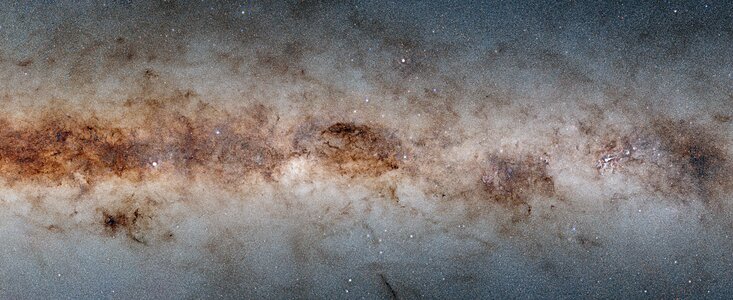

Counting A Sky Full Of Stars
18 January 2023
Have you tried counting the stars in a clear-night sky? How many bright objects can you identify? The Dark Energy Camera (DECam), built on the Cerro Tololo Inter-American Observatory (CTIO) in Chile, captured the most detailed picture of the galactic plane of our Milky Way as seen from the southern sky. And astronomers just released a catalogue containing data on a whopping 3.32 billion celestial objects – making it the largest catalogue of our galaxy ever made.
The Milky Way is a spiral galaxy containing hundreds of billions of stars. It has bright regions where new stars form, with dark regions made of thick clouds of gas and dust. On a clear night sky with zero light pollution, one can see the Milky Way as a bright band stretching across the sky – like a white brush-stroke in the black canvas of the night sky. The spiral arms where most of the stars and dust are located lie in its disk - the bright band shown in the image above.
Astronomers find it extremely challenging to observe stars and other celestial objects in the galactic plane. This is because dark clouds of dust can “eat up” light from the stars. Sometimes the light from other bright objects like nebulae can mix with starlight too. And in some cases, the stars can appear so close to each other in the images, that it is impossible to distinguish them separately.
Then the Dark Energy Survey Camera comes to the astronomers' rescue. It is an instrument built on the Víctor M. Blanco 4-meter Telescope at CTIO, a Program of NSF NOIRLab. DECam observed the southern sky in optical and near-infrared wavelengths. After two years of scanning the southern galactic plane in great detail, the Dark Energy Camera Plane Survey (DECaPS2) produced 10 terabytes of data, counting and identifying approximately 3.32 billion objects – roughly half the population of the entire world!
This is the second dataset release of the DECaPS2 and astronomers are excited for the wealth of research possibilities the survey opens up. For example, they will be able to map the three-dimensional structure of the Milky Way’s dust in great detail!
Image: The new survey dataset of the galactic plane of the Milky Way contains 3.32 billion celestial objects — the largest such catalogue so far. The data were taken with the Dark Energy Camera at the NSF’s Cerro Tololo Inter-American Observatory in Chile, a Program of NOIRLab.
Credit: DECaPS2/DOE/FNAL/DECam/CTIO/NOIRLab/NSF/AURA Image processing: M. Zamani & D. de Martin (NSF NOIRLab)
